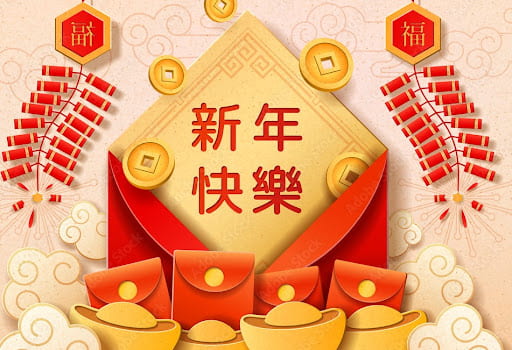Each year, the Lunar or Chinese New Year usually falls on the second new moon after the winter solstice. While the holiday is celebrated most enthusiastically in China, Indonesia, Malaysia, the Philippines, Singapore, South Korea, Vietnam, and Southeast Asia, it is also celebrated in some way in nearly every country in the world. And starting this year, Lunar New Year is now an official state holiday in California!
We asked USC students from Mainland China, Vietnam, South Korea, and Taiwan to share how they celebrate this colorful holiday:
Enpei Ding, Mainland China, M.S. in Marketing at the Marshall School of Business:
This year, I celebrated the New Year with my friends! Luckily, the Chinese cuisine in LA is pretty good, and my friends and I found a great restaurant. But back home, we would never go out. Our family would gather and prepare dinner starting in the early afternoon. We would have a spread of 10-15 dishes by dinner time! The best part? After the meal, elders give out bright, beautiful red envelopes (known as 紅包, hóngbāo)! These contain “lucky money” for the kids, symbolizing good wishes and luck for the new year ahead! The importance of the hóngbāo isn’t the cash held inside; it’s the envelope itself. The red symbolizes good luck and prosperity in Chinese (and other East Asian) cultures.
Jiahang Zhao, Mainland China, M.S. in Marketing at the Marshall School of Business:
This year, I kept up the tradition of making homemade dumplings on the Lunar New Year! The only change was that I made them with friends instead of the family! We made some lucky dumplings whose shapes resemble the gold ingots used as currency during the Ming Dynasty. An old legend says the more dumplings you eat during New Year celebrations, the more money you will make that year. I ate eleven!
Jonathan Huang, Taiwan, M.A. in Public Relations and Advertising at the Annenberg School for Communication and Journalism:
We do “Spring Cleaning” in Taiwan the day before New Year. There’s a belief that with all dirt, we also clean away all the “bad luck” so the new good luck can come in. Another exciting thing is red envelopes: parents and elders put money in there and give them to kids as presents. Why are they red? Because red is considered a lucky color in Chinese/Taiwanese culture. Therefore, there are a lot of red decorations everywhere during New Year. We also play “Mahjong,” a traditional Chinese dice game, and eat many dumplings. In some dumplings, we put coins for Good luck. So, if you eat a dumpling with a coin, you will be lucky.
Larry Li, Mainland China, B.S. in Physics/Computer Science at the Dornsife College of Letters, Arts & Sciences:
My family celebrates Chinese New Year by decorating our home with red lanterns, banners, and couplets bearing auspicious meanings. Red is considered a lucky color in Chinese culture and is believed to ward off evil spirits. We also cook dumplings, which symbolize wealth and good fortune, fish, which represents a wish for an excess of wealth, “nian gao” (a sweet, sticky rice pudding that is eaten as a dessert or offered as a gift); and noodles served to symbolize long life. Other traditions include lighting fireworks to scare off evil spirits, performing dragon and lion dances, and exchanging money-filled red envelopes. The duration of the celebration varies, but it typically lasts for 15 days and ends with the Lantern Festival, a day for families to come together, light lanterns, and watch lantern displays.
Athena Le, Vietnam, M.A. in Public Relations and Advertising at the Annenberg School for Communication and Journalism:
On Lunar New Year, we usually go to a temple to pray to Buddha and other Gods for the next year being good and lucky. We meet with friends and relatives there, worship the Gods, and celebrate the New Year by gathering at the table and eating vegetarian food. The food is vegetarian since it’s a good practice not to eat anything animal-related, and we pray for luck and health for the whole year.
Eric Choi, South Korea, B.A. in Communications at the Annenberg School for Communication and Journalism:
The decoration style is the main difference between the celebration of the Lunar New Year in South Korea and China. Compared to China, where red is the primary color of the holiday, in South Korea, we decorate our houses with different colors – the more colorful your decorations, the better. We also cook traditional food, gather with friends and relatives, and worship our ancestors for the next year, asking for a good new year.
Quinny Wu, Mainland China, B.A. in Economics at the Dornsife College of Letters, Arts & Sciences:
Chinese New Year is one of my favorite holidays since we make a lot of food! Usually, we cook loads of meat dishes, but my favorite one is Fat Choy, which means “rich” in Chinese. The more you eat it during New Year, the more lucks and money you’ll have in the next year. On New Year’s day, we also go to temples to pray to ancestors and gods – we spill warm white wine in front of the statues of gods, worship them, and make wishes for the following year. Another interesting tradition is that it’s prohibited to shower, bath, or clean the house on New Year’s. My grandmother told me it was bad luck.

Lunar or Chinese New Year is a beloved holiday in most Asian countries, which not only marks the arrival of spring, it signifies a fresh start and the beginning of new life. Celebrating this colorful holiday away from home, USC international students honor the traditions by cooking holiday dishes, playing games, and spending time with their loved ones here in the U.S. – their friends.
Written by: Devanshi Punch, M.A. Marketing Analytics, Marshall School of Business, Class of 2023
Written by: Yana Borodyuk, M.A. Public Relations and Advertising, Annenberg School for Communication & Journalism, Class of 2023
